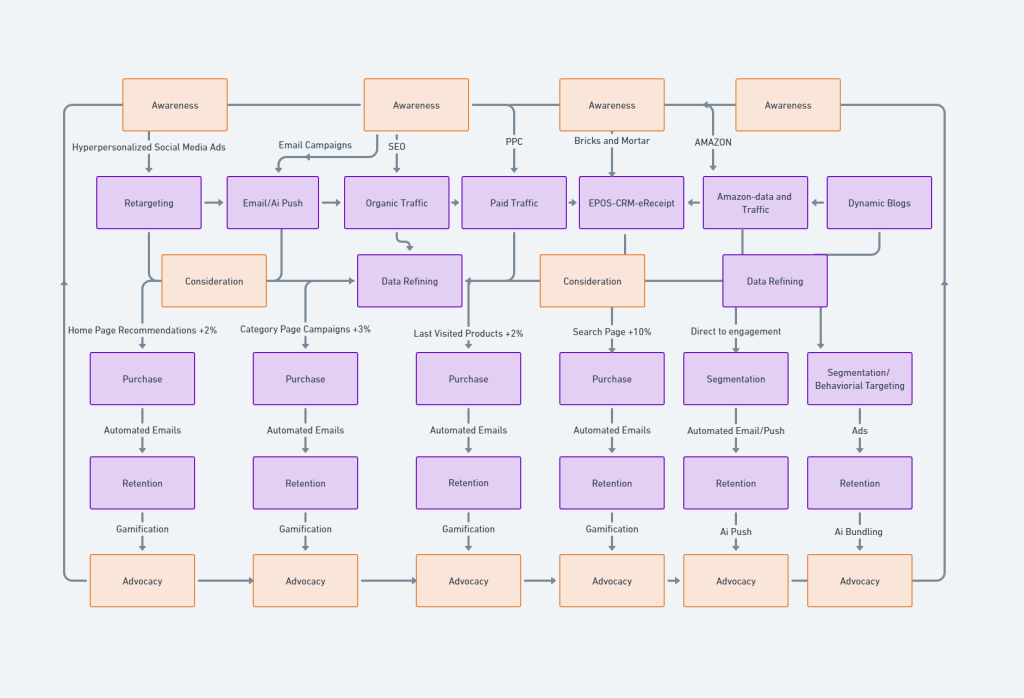Our websites use cookies. By continuing, we assume your permission to deploy cookies as detailed in our Privacy Policy.
Breaking Down Data Silos in eCommerce: Unlocking that Extra 30%
Insights gathered from an SEO campaign are very rarely shared in “real-time” with the email marketing or social selling channels and instead form part of the siloed data for SEO. Similarly, insights or trends created offline in your bricks-and-mortar very rarely re-merchandise a PDP page or a trigger email.
According to market research firm IDC, companies lose 20-30 % in revenue every year due to data inefficiencies.
Do that mental arithmetic right now: What is 30% of your sales worth? Dollarise it and get an exact sum before going further in the article.
Equipped with your exact figure, let us explore what data silos are, their impact on eCommerce operations, and how to interconnect data to increase efficiency in the eCommerce landscape.
Key Takeaways
- Data silos occur when information is stored and managed in isolated systems or departments, making it challenging to access and utilise data effectively.
- Scattered customer data hinders a comprehensive view of customers, hampering personalised marketing and cross-selling efforts.
- Data silos complicate report generation and meaningful analysis, hindering decision-making and data-driven strategies.
- They also limit teamwork and communication between departments, potentially causing inefficiencies and disjointed customer experiences.
- To break down data silos, centralise data storage, implement data integration tools, embrace APIs, and invest in Master Data Management (MDM) to create a unified data environment, fostering data consistency and accessibility across the organisation.
What Are Data Silos?
Data silos are insulated management systems that cannot work with other systems or are running parallel to one another but never connect.
In the eCommerce context, data silos can arise from various sources, such as customer relationship management (CRM) systems, inventory management systems, marketing platforms, and sales databases.
These silos often occur due to different systems being implemented at various stages of a business’s growth. Still, they most commonly are created because every channel and tool on the site is working separately from each other trying to deliver just one goal.
The Impact of Data Silos on eCommerce
Data silos hinder eCommerce businesses in several ways, impacting operational efficiency and hindering growth opportunities. Here are some key challenges associated with data silos:
Incomplete Customer Profiles
Customer data scattered across multiple systems prevents businesses from gaining a holistic view of their customers. This fragmentation inhibits personalised marketing efforts, targeted cross-selling and upselling opportunities.
Inefficient Inventory Management
Disconnected inventory systems can lead to inaccurate stock levels, resulting in missed sales opportunities or overselling products. Timely inventory updates and accurate demand forecasting are critical for meeting customer expectations and optimising resources.
Siloed Analytics and Reporting
When data is scattered across various systems, generating comprehensive reports and performing meaningful analyses becomes time-consuming and complex. This can hinder decision-making and prevent businesses from identifying trends or implementing data-driven strategies.
Poor Collaboration and Communication
Data silos limit effective communication and collaboration between teams. Departments working in isolation may duplicate efforts, leading to inefficiencies and disjointed customer experiences.
How to Break Down Data Silos
By embracing strategies for interconnectivity and data integration, you can unlock new levels of efficiency and break through the barriers of data silos. Here are some critical steps to consider:
Centralise Data Storage
Establish a centralised data repository or a data warehouse that consolidates information from various sources. This allows for easier data access and enables cross-system analysis.
Implement Data Integration Solutions
Deploy data integration tools that facilitate the seamless flow of information between different systems. These solutions can extract, transform, and load data in a standardised format, ensuring consistency and accuracy across the organisation.
Embrace Application Programming Interfaces (APIs)
APIs enable systems to communicate and share data in real-time. By integrating APIs into existing software systems, businesses can facilitate data exchange between departments and external platforms, promoting efficient data flow.
Invest in Master Data Management (MDM)
MDM solutions help establish a single, trusted source of truth by consolidating and standardising data across multiple systems. MDM enhances data quality, improves data governance, and ensures consistent information throughout the organisation.
Cultivate a Data-Driven Culture
Encourage cross-functional collaboration and data sharing within the organisation. Foster a mindset where data is seen as a valuable asset that drives decision-making and informs business strategies.
Leverage Data Analytics and Business Intelligence
Utilise robust analytics and reporting tools to derive meaningful insights from interconnected data. Advanced analytics can uncover patterns, trends, and customer behaviours that drive better decision-making and optimise e-commerce operations.
Breaking Down Data Silos: Should You Do It?
Identifying where the data is siloed and also ways to connect to it is just the first step of breaking down data silos.
Actioning it will take budget, time, and risk, which are the three leading killers of growth within today’s eCommerce industry.
So, what’s the alternative and is this worth it?
Let’s say your business brings in 500k each month in sales, so 30% is 12000 of a lost opportunity, and also, outside of revenue loss, you have growing unsubscribe rates and wasted hours on failed Facebook, Google, and email campaigns.
Now let’s add the cost of all the tools and data sources you have that create data but dump it all into silos:
- Amazon
- Brick-and-mortar data
- Chatbot
- Click and collect data
- CRM
- EPOS
- E-receipts
- Meta ads (Facebook and Instagram)
- PPC
- Price listing sites
- Push notifications
- Recommendations
- Search box
- Searchandising
- SEO
Each tool I’ve listed is more than likely disconnected from the following tool, which means there are 17 data silos full of rich data that can make you a lot more sales.
In other words, you are sitting on a rich data source but not utilising it correctly.
And what’s the point of collecting all this data if you cannot use it?
Connected Commerce with Segmentify
Segmentify is a growth and customer engagement platform built around an immensely powerful hybrid engine that combines self-learning AI with rule-based systems.
This platform, in just five working days without budget, developers or risk, will connect your complete online customer journey and use an uninterrupted data flow. Give them another ten days, and they will connect your offline brick-and-mortar as well.
Here is an example of what Connected Commerce should look like:

Segmentify refines your data by combining data from different sources:
- Smart customer segmentation: Algorithms based on order value, shopping frequency, and more! Learn more about them here.
- Rule-based segmentation:
- Purchase history
- Browsing history
- Demographic data
- Geolocation data
- Technology data
- Dynamic segmentation:
- Amazon gateway insights
- CRM data
- Customer affinities
- Email marketing data
- EPOS data
- Marketplace gateway insights
- Persona quizzes
- PPC gateway insights
- Product attributes
- SEO gateway insights
- Social media data
- Segmentify Analytics
The Segmentify platform then uses the real-time insights to deliver the right product to your customers across multiple touchpoints.
Let me explain a little deeper where the vast majority of eCommerce businesses are going wrong and how, with the use of Segmentify, you can quickly rectify this problem and deliver.
First Step: Identify Your Customer Personas
To identify your customer personas, you first need to answer some questions:
What makes each customer unique? What are their current and future needs? How do you analyse them? What data is necessary, and where is it currently in the business?
Let’s go over some example personas.
1. Janet the First-Time Visitor
Janet lands on your PDP by clicking on a Facebook or Google ad, through a PPC campaign or her best friend sent her a direct link.
What data has Janet shared with you so far?
- MAC or IP address
- Time and/or location
- Type of device
- Channel (social commerce, SEO, PPC, etc.)
- Personal preferences (style, brand, colour, etc.)
- Gender
- Age group
- Budget
She then leaves the page and exits the site. So where is this data held, and how do you use it to make more sales?
90% reading this will say the data is held in the Facebook Silo or the SEO Silo, and only the person in charge of that channel will ever have access to it. Ask yourself this: How will this data ever be used to drive sales on the site or used for retention purposes?
2. John the Secret Assassin
John hates being sold to, so when he goes onto eCommerce sites, he goes straight to the search box to get just what he needs and leaves the site.
So, John types in “soks” in the search box and your super-duper on-site search tool, which costs you over 700 bucks a month, can expertly correct his spelling and deliver his “socks”, and he leaves happy that you haven’t sold him two products.
But you can upsell to John.
So, how do you use data to upsell John with the search box?
Is it even possible to get a visitor using the search box to buy a second product? Or are you just going to admit defeat and let him leave with one purchase and an admiration for your super spelling service?
How do I turn the search box, which generates about 15% of my revenue on mobile, into a personal shopper that can upsell John and not disrupt his thought process or journey?
Also, how do I take the limited data John has given me and use it somewhere else to grow sales?
John is now part of the sock insights you need to use in your SEO strategy, email campaigns and Meta ads.
That’s how John’s on-site search data helps you upsell.
3. Mary the Loyal Customer
Mary, a loyal customer, returns to the website regularly. And today, she accessed the site via a link on Facebook.
Mary is looking at shoes this week, and since she’s a loyal customer, you know a lot about Mary: Her clothing size, favourite colour, budget, location and even what the weather is like where she is.
Right now, she is browsing party shoes to make her stand out and sparkle in the crowd.
So, she lands on the PDP page from Facebook, and you just deliver her a related products widget and maybe a recently viewed widget.
If she finalises a purchase, a push notification is triggered with a “Thank you for your purchase” message. What if she abandons her cart? Well, that triggers a cart abandonment email reminder.
Look at the Connected Commerce approach from Segmentify to Mary’s journey.
Using Segmentify, you can deliver Mary the following:
- 9 different algorithms in one widget from top trending to most clicked to similar design and price.
- AI-generated and rule-based product bundling —a whole outfit to go with those racy shoes where she can add her own flair with colours and designs.
- She may click on the search box looking for some inspiration as she is not sure if those shoes match her FRIYAYY feeling, which triggers the “Before Search” module. Before she types anything, you upsell her perfect alternatives, accessories to match and even a lovely scarf to go with the handbag she bought last month!
- Later that week, Mary is scrolling Instagram. You use her data and cross-reference it with everybody else who has bought comparable products on the site. Then you throw in all the insights gained from every marketing channel you’re using (email, Facebook ads, CRM, PPC, SEO, and even EPOS from stores) and with hyper-personalisation, you deliver the next right product before she even knows she needs it. Chef’s kiss!
- Her reaction is to send it to her best friend Janet, saying, “It’s only Monday, but I’m so getting this for the weekend!”
- Mary’s friend Janet is now a first-time buyer. The cycle continues and grows.
Wrapping Up
Data silos can hinder growth, efficiency, and customer experiences for the eCommerce industry.
Breaking down these silos and interconnecting data systems is crucial for thriving in today’s competitive landscape.
By centralising data storage, implementing integration solutions, embracing APIs, and fostering a data-driven culture, you can unlock the full potential of your data, optimise operations, and deliver exceptional customer experiences.
Embracing interconnected data is not only a pathway to efficiency but also a driver of growth and success.
Don’t let time and budget constraints be the barrier to your growth. Let’s take a deep dive into your business together and deliver a strategy that unlocks your data and delivers growth.
Test the ROI before committing to anything.





